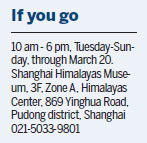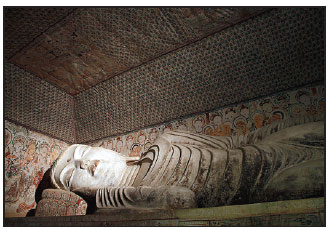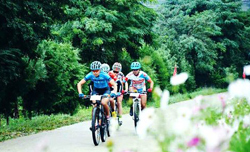News
Shanghai gets a glimpse of rare treasures from Gansu
Updated: 2015-12-15By Zhang Kun In Shanghai ( China Daily )
Dunhuang is a small town surrounded by the Gobi desert in Northwest China's Gansu province. It is a Mecca for Buddhist art for many.
From the 4th century to the 14th, artists and craftsmen made carvings inside mountain caves there and also created mural paintings, Buddha statues and other artworks. Today the caves are known as Dunhuang Grottoes, spanning more than 1,680 meters, a UNESCO World Heritage site.
An ongoing exhibition at the Himalayas Museum in Shanghai's Pudong area offers a glimpse into the great art and history of Dunhuang.
Dunhuang - Song of Living Beings is the first large-scale show of Dunhuang art in the city. The exhibits consist of 165 sets of original works and artifacts.
The museum refurbished its central exhibition hall to present eight replica caves that represent the highest artistic value of the Dunhuang Grottoes.
Also on show are 11 copies of painted stucco statues and 60 copies of murals, all made by artists and craftsmen from the Dunhuang Art Institute (the precursor of the Dunhuang Research Academy), who have worked on the restoration and protection of Dunhuang for decades.
The exhibition is co-curated by Wang Xudong, director of Dunhuang Research Academy, and Wong Shun-kit, advisor to the Himalayas Museum.
This is the first time the academy has joined hands with a private museum to present an exhibition, says Wang.
The exhibition also includes a number of contemporary artists' work from home and abroad, scattering them among the ancient paintings and sculptures.
Wang believes this curatorial design will build connections between the ancient Dunhuang art and the modern times, and inspire more interest in the spiritual world reflected in the grottoes.
Yongwoo Lee, chief academic advisor for the exhibition, says it is the great faith in Buddhism and love for life that enabled the continual creation of grotto art in Dunhuang for more than 1,000 years.
"People had artists painting murals and making statues as their offerings to the Buddha," says Fan Jinshi, honorary director of the Dunhuang Research Academy. She is also known as "the daughter of Dunhuang" for her preservation efforts.
Born in 1938, she joined the Dunhuang Art Institute upon graduation from Peking University in 1963, and has worked there ever since.
Dunhuang art includes examples of secular life, including images of dedicated Buddhists who commissioned the artworks. Also, folklore, historical stories and social life are among the subjects of mural art.
Dunhuang is located along the ancient Silk Road, and was a major hub for business and trade. The grotto art reflects the cultural interactions and diverse racial and ethnic composition of the time, says Wang.
The National Dunhuang Art Institute was founded in 1944, when the protection, research and restoration of Dunhuang art started. Through the past decades, scholars and researchers from all over the world have worked there, and yet "the more we learn about it, the more we realize how infinitely deep and boundlessly wide Dunhuang is", says Fan.
"What is the painting about? Why was it painted like that? What era is the building from? What were clothing styles back then? There are millions of questions to be asked and answered," she says.
Patterns from Dunhuang have been adopted in the building of many landmark structures in China. Music and dance have been composed according to the images and historical documents from Dunhuang. She believes Dunhuang still has a lot to offer that will impact modern culture.
Unlike in Italy or France where great artworks were attributed to very famous artists, in Dunhuang the artists and craftsmen hardly left any personal record.
Guan Youhui, 83, a researcher who has worked in Dunhuang since 1954, says this was because the artists then earned poorly and had low social status.
Among the historical records in the grottoes, he once found a contract signed by a craftsman selling his son because of poverty.
"Nobody as they were, those ancient artists had great techniques and created masterpieces that have survived centuries," he says.
Dunhuang opened its grottoes to visitors in 1979. At the beginning, it received no more than 40,000 visitors a year, but this year 1.1 million people went to see the grottoes. This has brought lots of challenges in the protection of Dunhuang, Wang says.
In order to minimize the damage caused by large numbers of tourists, Dunhuang's authorities have imposed restrictions on visits to the grottoes, and a new reservation system is in place.
"Please remember to make a reservation online before you visit," says Fan.
"Otherwise you will have to wait in a long line, and be able to access only a few grottoes and open zones."
She also suggests visitors avoid the summer vacation and national holidays when the area is crowded.
|
The Buddha statue is among 165 sets of original works and artifacts on shown at Dunhuang - Song of Living Beings.Provided To China Daily |




